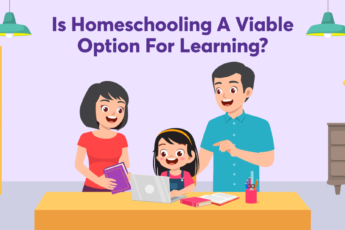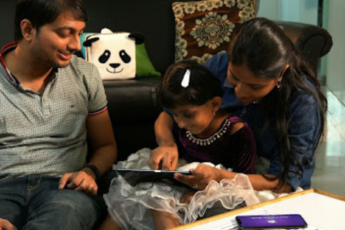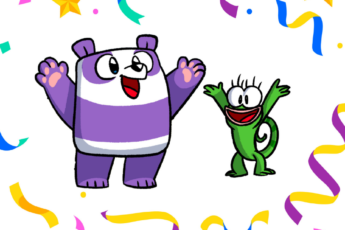6 Activities To Nurture Multisensory Awareness In Early Childhood
Touch. Sight. Sound. Hearing. Taste.
A child’s experience in this world is one of multisensory stimulation. It is likely that evolution itself supports optimal functioning in such an environment. While all children reach their developmental goals at different paces, research suggests multisensory learning is one of the most effective strategies to enhance the learning experience.
*About ‘Multisensory’ And ‘Multisensory Learning’: The term ‘multisensory’ means using more than one sense at a time, while ‘multisensory learning’ incorporates learning techniques that use multiple senses at the same time. For example: Adding audio or visual aids into teaching and assignments. Not every lesson does (or needs to) include each sense, but such an approach does require more than one sense to be stimulated at a time for better learning outcomes.
Multisensory activities are based on the concept of ‘whole brain learning’, which is the belief that the best way to teach concepts is to involve all areas of the brain. In his book, the Theory of Neuronal Group Selection (1987), American biologist Gerald Edelman wrote that more elaborate brain connections are formed with multisensory learning as compared to single sensory learning, greatly enhancing comprehension and retention. To learn more about connections in the brain and how they help with memory retention, consider reading how to help children retain learning.
Multisensory learning also proves effective to different types of learners: visual learners, auditory learners, tactile learners, and physical or kinesthetic learners. This ensures multisensory instruction reaches every learner in the classroom.

To help children enhance their multisensory awareness, we curated simple multisensory learning activities that tie into early childhood education and can be easily incorporated into the classroom or home:
Note: Each activity can be used (and tweaked) depending on children’s learning levels and interests.
Activity Name: Handprint Birds

You Will Need:
- Paint
- Glue
- White paper
- Coloured pencils and/or crayons
- Kid-safe scissors
Method: Paint children’s palms with one colour, and their fingers multiple colors like red, yellow, and green. Guide them to place their hands, palms down, on a sheet of white paper to create a handprint. On the thumb area, help them draw a beak using colored pencils or crayons. Draw an eye, a pair of feet, and you have a handprint bird! You can cut this out and make a sign or card, too.
Learning Outcomes: Fine motor skills, colour identification, creative exploration
Activity Name: Colored Corn Art

You Will Need:
- Glue stick
- 1 cup of regular corn kernels
- Vinegar
- Water
- Food coloring
- Containers for mixing food coloring (bowls, plastic cups, etc)
- A sheet of paper
Method: Fill half the container(s) with water and add an equal amount of vinegar to it. Ask children to choose food coloring(s) of their choice, and mix them into the container(s). Then add in a small amount (about half a cup) of corn kernels and leave them to soak overnight. The next day, ask the children to dry the corn kernels with paper towels. Ask each child to get a glue stick, a sheet of paper, and some of the colored corn. Encourage them to use some creativity to make fun designs with the different colors! (Note: it’s easier to add glue to the sheet and then stick the corn to it.)
Learning outcomes: Fine motor skills, socio-emotional development (patience), creativity
*Not recommended for younger children as there is a choking hazard.
Activity Name: Apple Basket Word Sort

You Will Need:
- Red or green paper
- Colored pencils or markers
- A basket
- Kid-safe scissors
Method: On apple-shaped cutouts (created by children from red and/or green paper), write CVC (i.e., consonant-vowel-consonant) words like MAP and HAT. Write as many words as the children can identify at their age. Mix up these ‘paper apples’ and place a basket in front of children. Call out the words at random and ask them to pick the right apple cutout and place it in the basket.
Modification: Repurpose this to enhance foundational numeracy skills; switch out the words for numbers.
Learning Outcomes: Vocabulary, colour identification, sorting, creativity, fine motor skills
*For online classes, you can ask parents to help you.
Activity Name: Popsicle Scarecrow

You Will Need:
- Glue
- Popsicle sticks
- Pens/pencils/crayons
- Buttons, beads, threads, ribbons (for extra ‘decoration’)
Method: Ask children for help in protecting the garden. They need to make a popsicle person to scare away pests like crows and mynahs. Glue the narrow sides of 4-5 popsicle sticks side-by-side, to make the body. Break one popsicle in half to make the arms, and glue them lengthwise. Use two popsicle sticks as the legs. Draw on some features, and even stick cotton or thread for the hair. Add to the multisensory approach by putting this scarecrow into a real garden, if you can access one. If not, you can even put it into a potted plant.
Learning Outcomes: Fine motor skills, creativity, environmental awareness
Activity Name: Road Trip

You Will Need:
- Toy vehicle (car, truck, etc) OR you can use any random object as a ‘vehicle’
- A plain sheet of paper
- Pen/pencil/crayons
- Tiny popsicle people
- Matchboxes
- Small cotton balls/balls of paper
Method: Take your little learners on an imaginary road trip. Draw a winding road on the paper. Decorate the sheet with matchboxes (for buildings and houses), add in some cotton/crushed paper as rocks and boulders. Drawn fields that are guarded by scarecrows or farms with scarecrow people in them. Place the vehicle at the start of the road; ask children to move it along the path. As they travel from place to place, ask them to create stories, identify the elements, and gradually make their own little roadmap.
Modification: Improve early literacy skills by writing names on buildings (school, hospital, etc.), and asking children to read, and later spell it themselves.
Learning Outcomes: Imagination, creativity, fine motor skills, storytelling, early literacy skills
Activity Name: Button Tree

You Will Need:
- Multicolored buttons (red, yellow, orange, brown, green)
- Colored pencils, crayons, and markers
- Glue stick
Method: Trace out a tree trunk and branches together with children. Give them glue sticks and ask them to glue buttons to the branches to make a colourful button tree.
*You can use cotton balls, rolled up bits of paper, actual dried leaves, or anything else to make this tree.
Modification: In later levels, you can ask children to group particular colours together, add fruits, little hand painted birds, and anything else they can think of.
Learning Outcomes: Fine motor skills, colour identification, sorting and grouping, environmental awareness, creativity, exploration and imagination, observation.
To drive their intrinsic motivation to keep coming back and learning, children need to engage with the learning process. This is where multisensory activities and instructions fit in; they present information through more than one sensory system at a time, encouraging optimal learning.
At Square Panda, we understand the value of multisensory learning. Our programs — for children and for educators — include content that uses all the learning pathways in the brain (auditory/visual, kinesthetic/tactile) to enhance multisensory exploration for robust educational outcomes in early childhood education. Learn more about our holistic NEP 2020-aligned programs: ecce.squarepanda.in
Share a video of your little learners working on the above activities, and we’ll make sure to mention you on our social media.
Think someone you know will benefit from this article? Forward it to them.




Leave a Comment